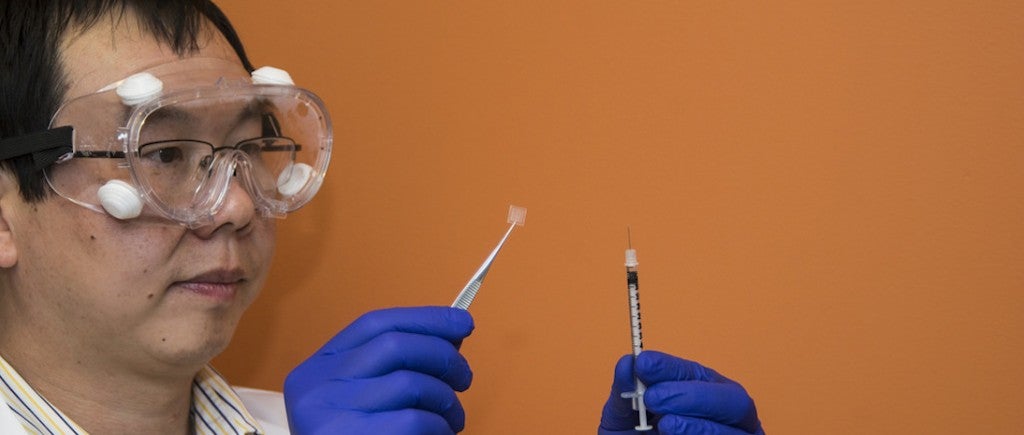RESEARCH | No Pain, New Gain
Spring 2016
We’ve all been through them as kids—painful needle sticks for multiple vaccinations. And even if we don’t remember them, our parents do.
Now, Xinyuan Chen, an assistant professor of biomedical and pharmaceutical sciences, in the College of Pharmacy, is developing a laser-based vaccine delivery system that would eliminate traditional hypodermic needle injections. And he’s starting with a powdered vaccine and accompanying drug delivery system that he believes could lead to one of the most effective methods of combating cigarette smoking and other tobacco use.
After seven years at Massachusetts General Hospital in Boston, he joined URI and brought with him a $1.08 million career development grant from the National Institute of Drug Abuse and a $432,000 grant from the National Institute of Allergy and Infectious Disease.
Typical vaccines fight diseases, but Chen’s nicotine vaccine and delivery system fight addictive behavior by blocking nicotine’s entry into the brain. Described as “a laser-based epidermal (skin) powder delivery” system for improved nicotine vaccination, the laser treatment generates micro-channel arrays, or micro-pores in the skin, through which a powdered vaccine is delivered from a patch applied onto the skin. The entire process is pain free.
One of the critical parts of the research involves adjuvants—ingredients added to vaccines to enhance effectiveness. Aluminum gels or salts are adjuvants used safely in a number of childhood and adult vaccines to improve their effectiveness. But some vaccine adjuvants can be toxic.
Chen said epidermal powder delivery is a novel skin delivery technology capable of minimizing vaccine/adjuvant-induced skin reactions through the delivery of vaccine and powerful additives into hundreds or thousands of separated micro-channels surrounded by normal healthy skin. In other words, the vaccine and its additives are administered in small doses across many sites on the skin, resulting in less potent site reactions.
In his lab, Chen displayed a small (6 by 6 millimeter) patch made of contact lens material and a small vial of powdered nicotine vaccine. That tiny patch, with 81 channels, can deliver 810 micrograms of medicine. The typical flu shot contains 45 micrograms of medicine.
One of his goals is to eventually use the pain-free, needle-free system to eliminate the 30 to 40 needle injections babies receive in their early years. — Dave Lavallee
Continue reading the Pharmacy Newsletter →
 Home
Home Browse
Browse Close
Close Events
Events Maps
Maps Email
Email Brightspace
Brightspace eCampus
eCampus



